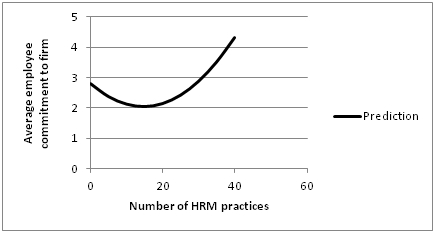Positive Employee Attitudes: How Much Human Resource Management Do You Need?
Positive Employee Attitudes: How Much Human Resource Management Do You Need?
Positive Employee Attitudes: How Much Human Resource Management Do You Need?
Why do firms spend so much on their human resource management (HRM) practices – like team-working, management-staff Q&A sessions, quality circles, job rotation, multi-skill training, and so on? In many cases, they assume that HRM will benefit the firm by motivating workers and encouraging ‘positive’ attitudes. Yet there is little hard evidence of a link between the HRM practices firms use and how their employees respond. Research appearing in this month’s Human Relations fills this gap.
The research shows that positive attitudes only emerge when firms practice HRM on a large scale: when firms try HRM in a piecemeal fashion, attitudes don’t improve at all. This is depicted in the chart.
Roughly half the workplaces in Britain’s private sector have a sufficient number of HRM practices to elicit positive employee attitudes, with the other half falling short.
Why is it that firms need to deploy HRM intensively if they are to elicit positive employee attitudes? We argue that firms are only able to signal strongly that they are interested in involving and engaging workers when they commit their organization fully to high involvement management. The partial implementation of such practices does not go far enough.
Does this mean that firms are wasting their time if they have partial systems of HRM? Perhaps. But there may be cost barriers to extending HRM which differ across employers, making intensive HRM a less worthwhile option for some. However, on the basis of the evidence presented in this paper, it is reasonable to conclude that firms that deploy HRM in order to elicit positive employee attitudes and, in that way, improve firm performance, are wasting their time unless they adopt a large number of practices.
Notes
1. Positive Employee Attitudes: How Much HRM Do You Need? by Michael White and Alex Bryson, Human Relations, 66, 3: 385-406 http://hum.sagepub.com/content/66/3/385.abstract
2. The data for the research are the Workplace Employment Relations Survey 2004. These are linked employer-employee data for Britain which are representative of workplaces with 5 or more employees. The analysis is confined to workplaces in the private sector. The research links employees to the workplaces that employ them: interviews with HR managers describe the array of HRM practices deployed at the workplace, while employees tell us how motivated they are and how satisfied they are with various aspects of the work they do.
3. The authors acknowledge the Department of Trade and Industry, the Economic and Social Research Council, the Advisory, Conciliation and Arbitration Service and the Policy Studies Institute as the originators of the 2004 Workplace Employment Relations Survey data, and the Data Archive at the University of Essex as the distributor of the data. The National Centre for Social Research was commissioned to conduct the survey fieldwork on behalf of the sponsors.

















